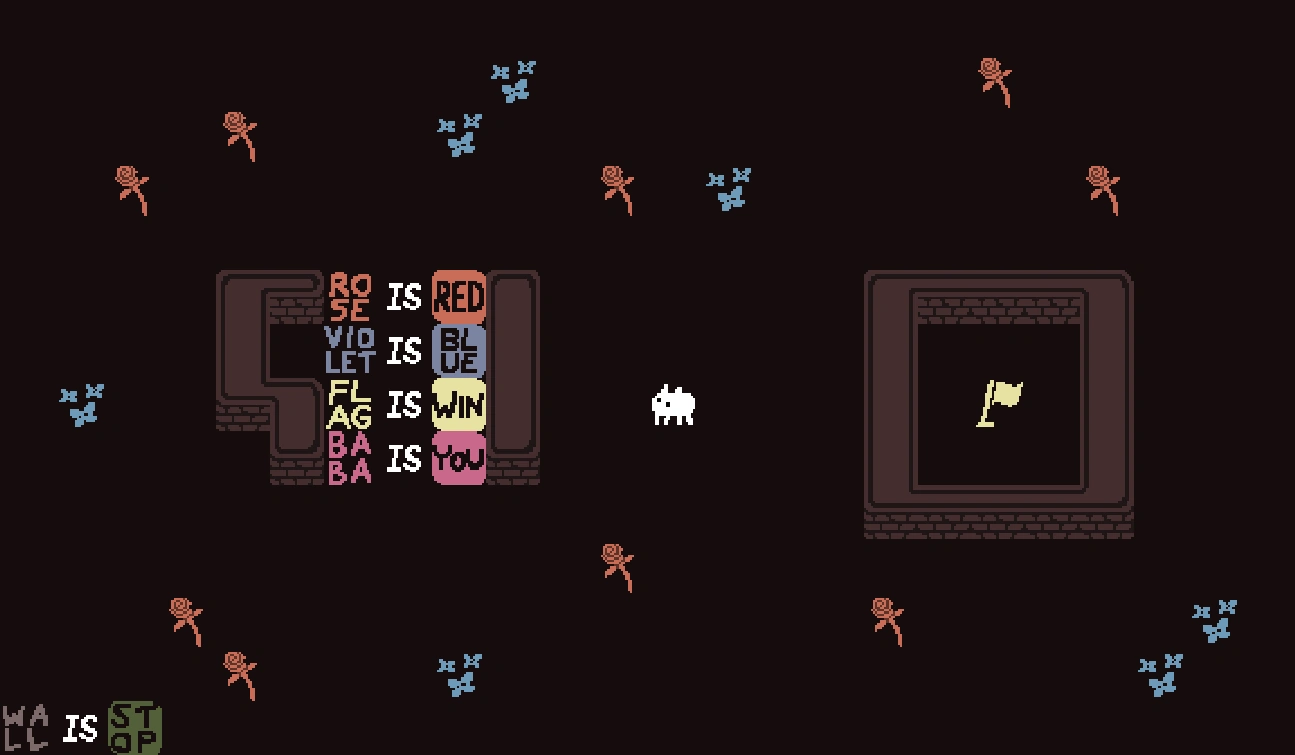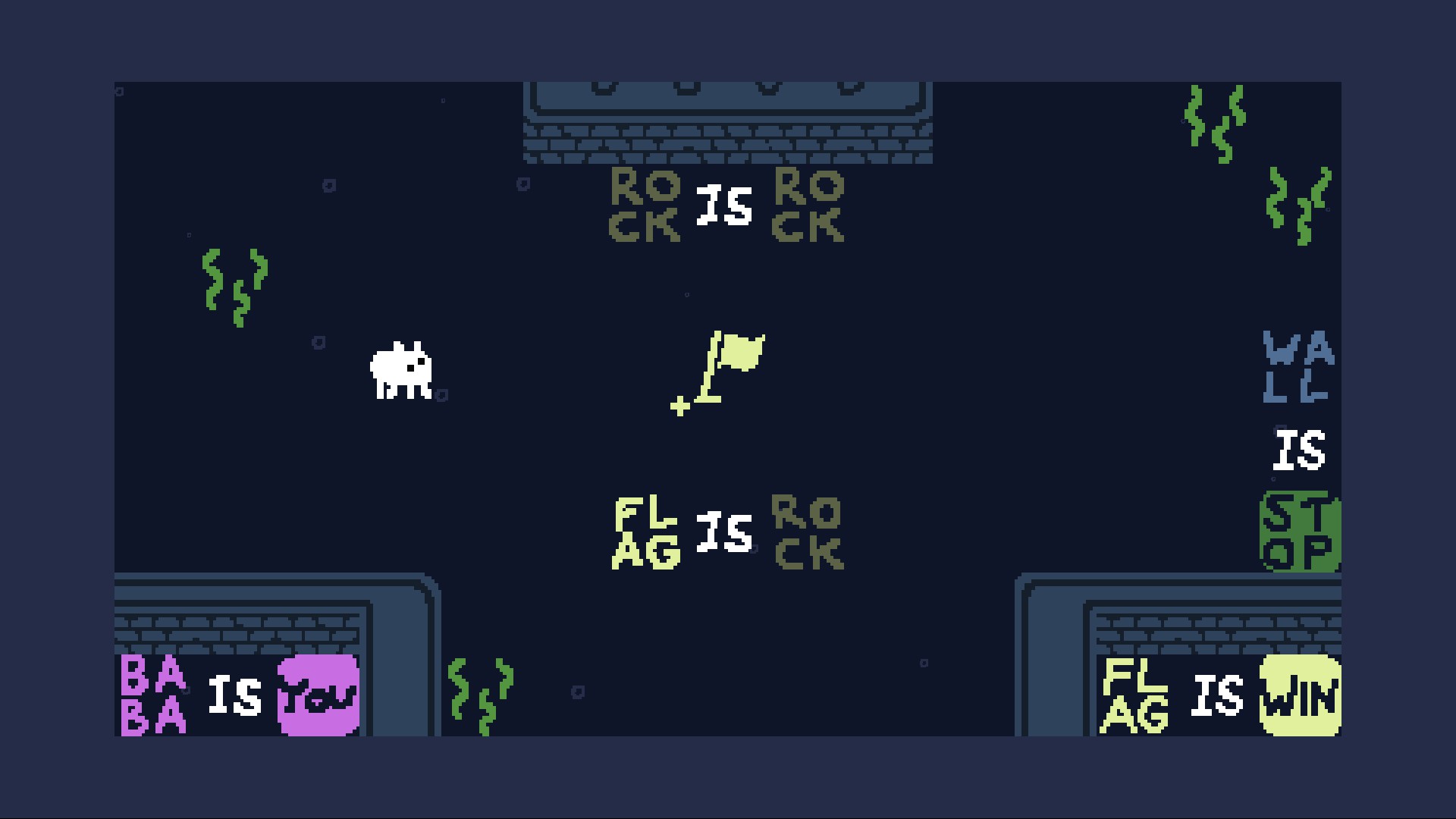
Baba is Sign
Jan 12, 2020
Baba is You was my game of the year. It's a mind-blowing puzzle game and it has cute graphics. But beyond that, it's also the perfect game for a semiotic analysis!

This might not often be relevant when talking about games; but I studied linguistics in college, and that was a while ago... Also, linguistic theories can get quite complicated, even when you didn't forget about half of them. So I'll try to keep it as simple as possible.
Baba is You is essentially a sokoban game, but instead of crates, you get to move blocks of texts that constitute the rules for the current level, or what those text blocks represent in the game world, i.e. you can push a block of text that says rock as well as an image of a rock on the screen.
In semiotics, the study of signs, these two notions together can be called the sign rock. Using Ferdinand de Saussure's terminology the word rock would be the signifier, which means it's merely a form that a sign takes, such as a word or icon, whereas the image of a rock in the game would be signified, which is what the signifier represents in our minds (or the game screen?). Semioticians like to deconstruct signs, because meanings are unstable and what a signifier signifies can change over time and according to context. Just like in Baba is You: Solving the puzzles in the game actually requires manipulating its rules, therefore changing the positions of the text blocks on the screen, which results in changes in their signified representations. For example, the three block rule flag is win, standing together, means reaching the signified flag is the win condition in a level. In a situation where your player-character has no access to the signified flag, but the signifier flag, and another sign combination, such as a rock and the text rock, changing the signified rock to a signified flag, by forming the rule rock is flag, can be the solution to the level, as this will turn the signified rock into a signified flag that is accessible.

However, signifier and signified, as a binary system, might be misleading, and although my rock example makes it look like the objectual representation= signified, meanings are more complicated than that. Think of René Magritte’s famous painting; the word “pipe” is a text referring to a pipe, but the image of a pipe is not the referent, instead, simply an image of a pipe. Charles Sanders Peirce makes another categorization of sign systems, and he splits a sign into three components: representamen, object and interpretant. And I feel like this might be a better fit for the case of Baba is You , especially in situations where you have a rule like the titular one Baba is you. Baba, the main character in the game, is pictured as -what I would like to think as- a white bunny on the screen. The rule Baba is you means that the player is in control of Baba. So the text Baba, signifies two things simultaneously: the fact that Baba is that white bunny and that you control it. This is where Peirce's categorization differs from Saussure's. Peirce's term object simply refers to the subject matter of a sign, so in the example of Baba is you, it would be the objectual image of Baba on the screen, while what he calls interpretant refers to the meaning of the sign, which would be Baba in the sense of the player-character (or you) on the screen. The text-block Baba, on the other hand, would be "representamen", which is just the Peircian name for Saussure's "signifier" as far as I understand.
While Baba is You asks you to decide and mess with what a signifier means and represents, there are of course some limitations that make it impossible for you to just put together a sentence like Baba is win and complete every level with ease. For example, you are free to break the sentence Baba is you apart, by moving its components around, but doing so will result in you not being your player-character Baba, and you can't control anything on the screen anymore, unless you have put together another rule, such as rock is you to claim yourself as an object instead of Baba. This means there has to be a signifier or representamen which represents the idea of you at all times. But you can also be a part of another sign at the same time, thus giving you multiple properties. The game often provides a limited number of accessible text-blocks and forces the players into forming a horizontal and a vertical sentence that share a single block of text, such as:

This mechanic makes the game more complex, because it makes the players think of the blocks as more than just pairs of pictures and texts. According to semiotics, this is also how linguistic signs work, they only make sense in relation to each other (a huge part of Saussure’s theory and chess analogy). If that doesn't sound complicated enough, also keep in mind that signs can be a signifier of another sign system as well, and this way we keep building meanings on other meanings. Baba is You also wants you to use meta-signs and think of each sign in relation to others, but it also takes advantage of associations that players make outside of the screen. While playing the initial levels, I spent several minutes trying to figure out how I can go behind a wall, until I noticed that I could simply walk through it. As the rules for every level are literally written on the screen, if an object has no information in the form of a sensical and coherent text, it has no properties. So unless you see a text that says wall is something, it won't have any mechanical attribute, as if it's not there. But even after I figured this out, I sometimes found myself thinking a wall or lava was blocking my way when there was no such rule. Sure, the game still has many levels where you see box is push, wall is stop and key is open, which makes it even more of a challenge to notice that they're not doing what they are expected to do, when the rules are different.
In semiotics the relationship between a signifier and signified can be on two levels; which are denotation, the literal meaning, and connotation (theorized mainly by Barthes). And although Baba is You is not a story-heavy game, a different setting and visuals, or lack of them, (if you pushed around geometric shapes, for example) could eliminate the challenge of misleading connotations. The words "wall" or "box" in the game have much stronger connotations than "Baba", and if all signs in the game would be names such as Baba and Keke (which are both based on a linguistic experiment!) or simply gibberish, it would be less fun in my opinion, because it wouldn't challenge the connections my mind tries to make.
I don’t think that Baba is You is intended to be a game about linguistics, and it doesn’t need to be, but just I like how semiotic theories are applicable to this game when it comes to deconstructing stuff and sense-making. If you still haven’t played Baba is You, it’s available on Steam and Nintendo Switch.